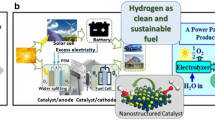Abstract
The exaltation of mass transfer of discharging cations, caused by the concurrent hydrogen evolution from acidified solutions, results in a sharp increase in the metal deposition rate. In this case the limiting process rate depends linearly on the hydrogen evolution current density; it depends but weakly on the solution agitation and temperature. Under the electrolysis of solutions containing weak acids as a supporting electrolyte, the higher the acid formation constant, the more pronounced is the dependence of the electrodeposition limiting rate on the hydrogen current density. When microelectrodes are used, the varying of the background acid nature may affect the hydrogen evolution rate markedly, while the metal electrodeposition rate mainly depends on the cell voltage. When metals are electrodeposited from complex anions, the parallel hydrogen evolution hinders the mass transfer; this process depends on the anion stability constant and charge, all other conditions being the same. The found peculiarities can be used in the inversion voltammetry for the lowering of the metal detection limit, improving of the analysis selectivity, and time saving.
Similar content being viewed by others
References
Levich, V.G., Fiziko-khimicheskaya gidrodinamika (Physicochemical Hydrodynamics), Moscow: Fizmatgiz, 1959.
Brunner, E., Z. Phys. Chem., 1904, vol. 47, p. 56.
Euken, A., Z. Phys. Chem., 1907, vol. 59, p. 72.
Heyrovsky, J. and Kuta, J., Aklady Polarografie, Prague: Nakl. Cheskoslovenske Akad. Ved., 1965.
Kharkats, Yu.I., in Itogi Nauki Tekh., Ser.: Elektrokhim., Moscow: VINITI, 1991, vol. 38.
Kletenik, Yu.B., Tarasova, V.A., Aleksandrova, T.P., Skvortsova, L.I., Zamyatin, A.P., Kiryushev, V.N., and Bek, R.Yu., Zh. Anal. Khim., 1999, vol. 54, p. 51.
Kletenik, Yu.B. and Aleksandrova, T.P., Zh. Anal. Khim., 1997, vol. 52, p. 280 [J. Anal. Chem. (Engl. Transl.), vol. 52, p.].
Newman, J., J. Electrochem. Soc., 1966, vol. 113, p. 501.
Vetter, K.J., Elektrochemische Kinetik, Berlin: Springer, 1961.
Kharkats, Yu.I., Elektrokhimiya, 1999, vol. 35, p. 1119.
Bek, R.Yu., Shuraeva, L.I., and Skvortsova, L.I., Elektrokhimiya, 2001, vol. 37, p. 241.
Kletenik, Yu.B., Aleksandrova, T.P., Tarasova, V.A., Skvortsova, L.I., Kiryushev, V.N., and Bek, R.Yu. Zh. Anal. Khim., 1999, vol. 54, p. 56.
Bek, R.Yu., Kiryushov, V.N., Skvortsova, L.I., Aleksandrova, T.P., and Tarasova, V.A., Zh. Anal. Khim., 2000, vol. 55, p. 1190.
Ibl, N., Metall Oberfläche, 1970, no. 10, p. 365.
Shuraeva, L.I., Bek, R.Yu., and Skvortsova, L.I., Elektrokhimiya, 1999, vol. 35, p. 649.
Skvortsova, L.I., Tarasova, V.A., Aleksandrova, T.P., and Bek, R.Yu., Zh. Anal. Khim., 1999, vol. 54, p. 424.
Shuraeva, L.I., Skvortsova, L.I., and Bek, R.Yu., Elektrokhimiya, 1999, vol. 35, p. 1149.
Spravochnik khimika (Reference Book of Chemist), Moscow: Gos. nauch.-tekhn. izd. khim. lit., 1192, vol. 3.
Dvorak, J., Koryta, J., and Bohackova, V., Elektrochemie, Prague: Academia, 1975.
Kuz’minskaya, G.E., Kublanovskaya, A.N., and Kublanovskii, V.S., Ukr. Khim. Zh., 1949, no. 10, p. 941.
Spravochnik po elektrokhimii (Reference Book in Electrochemistry) Sukhotin, A.M., Ed., Leningrad: Khimiya, 1981, p. 16.
Bek, R.Yu., Shuraeva, L.I., Kiryushov, V.N., and Skvortsova, L.I., Elektrokhimiya, 2000, vol. 36, p. 77.
Bek, R.Yu. and Shuraeva, L.I., Elektrokhimiya, 2001, vol. 37, p. 487.
Bek, R.Yu. and Shuraeva, L.I., Elektrokhimiya, 2001, vol. 37, p. 1327.
Skvortsova, L.I. and Kiryushov, V.N., Zh. Anal. Khim., 2000, vol. 55, p. 512.
Kalcher, K., Liland, W., and Vytras, K., Electroanalysis, 1996, vol. 8, p. 336.
Brainina, Kh.Z., Neiman, E.Ya., and Slepushkin, V.V., Inversionnye vol’tamperometricheskie metody (Stripping Voltametric Methods), Moscow: Khimiya, 1988.
Aleksandrova, T.P., Skvortsova, L.I., Kiryushov, V.N., and Bek, R.Yu., Zh. Anal. Khim., 1999, vol. 54, p. 851.
Author information
Authors and Affiliations
Corresponding author
Additional information
Original Russian Text © R.Yu. Bek, L.I. Shuraeva, L.I. Skvortsova, T.P. Aleksandrova, V.A. Tarasova, 2008, published in Elektrokhimiya, 2008, Vol. 44, No. 4, pp. 533–544.
Rights and permissions
About this article
Cite this article
Bek, R.Y., Shuraeva, L.I., Skvortsova, L.I. et al. Exaltation effects in the metal electrodeposition from acid electrolytes. Russ J Electrochem 44, 493–503 (2008). https://doi.org/10.1134/S1023193508040150
Received:
Published:
Issue Date:
DOI: https://doi.org/10.1134/S1023193508040150




